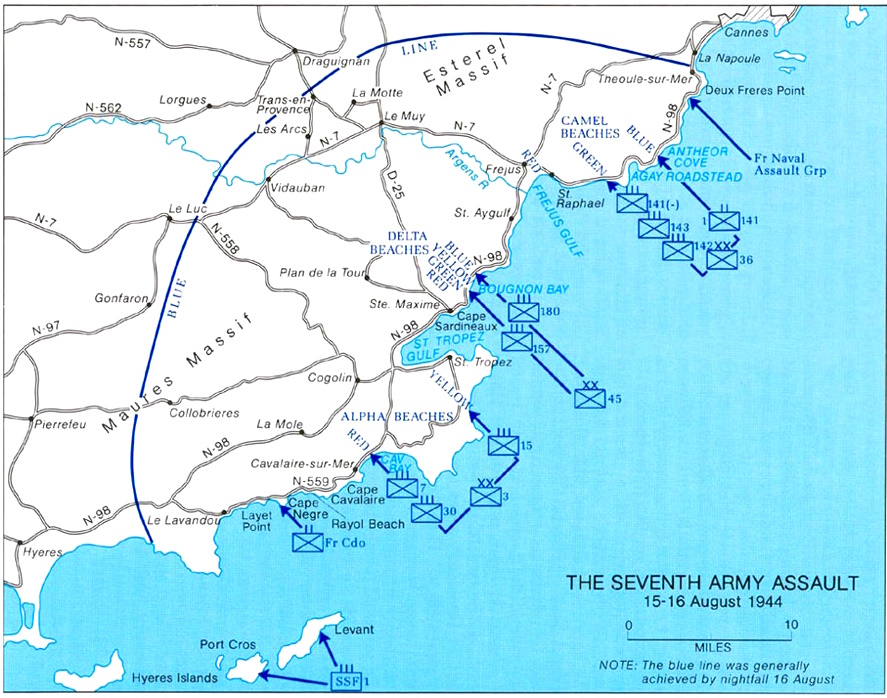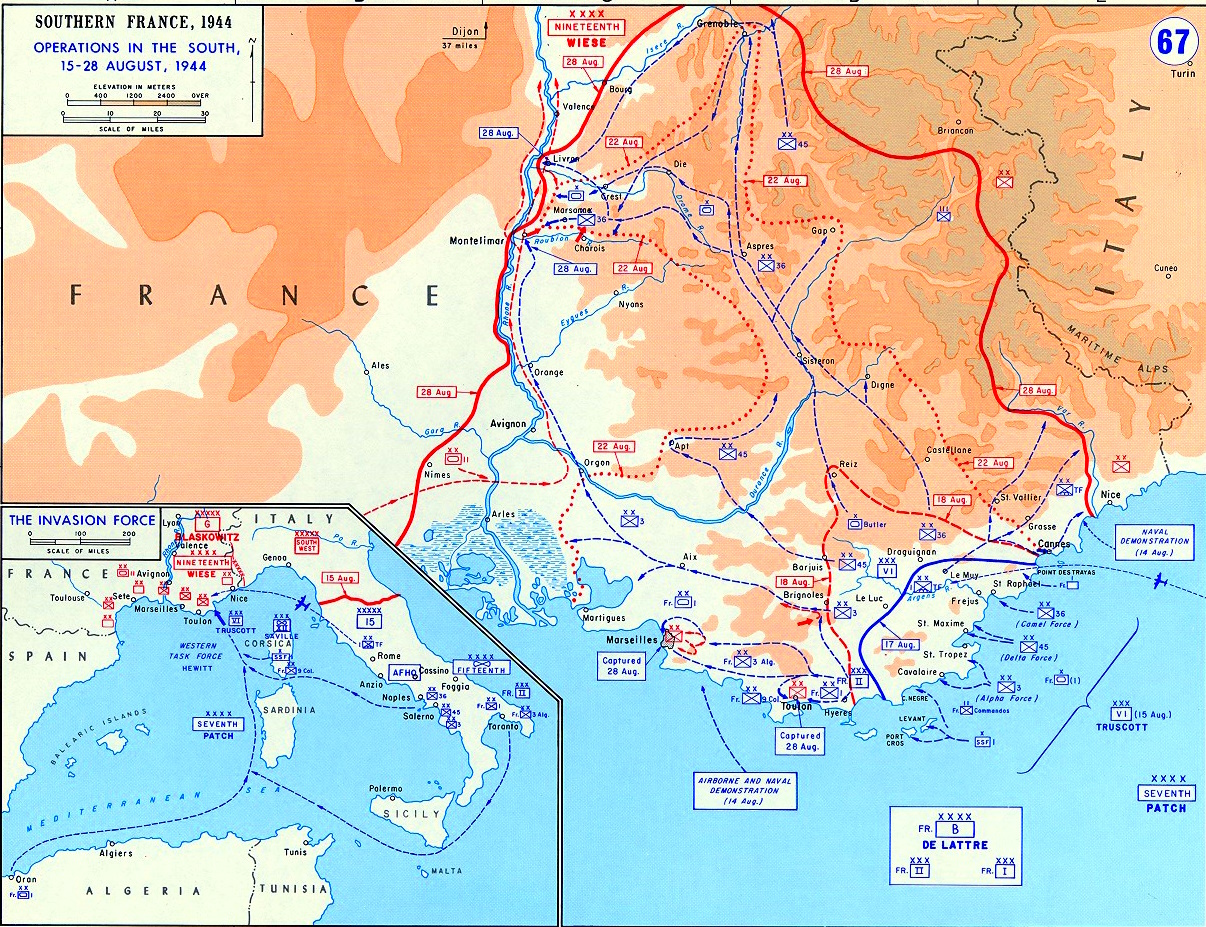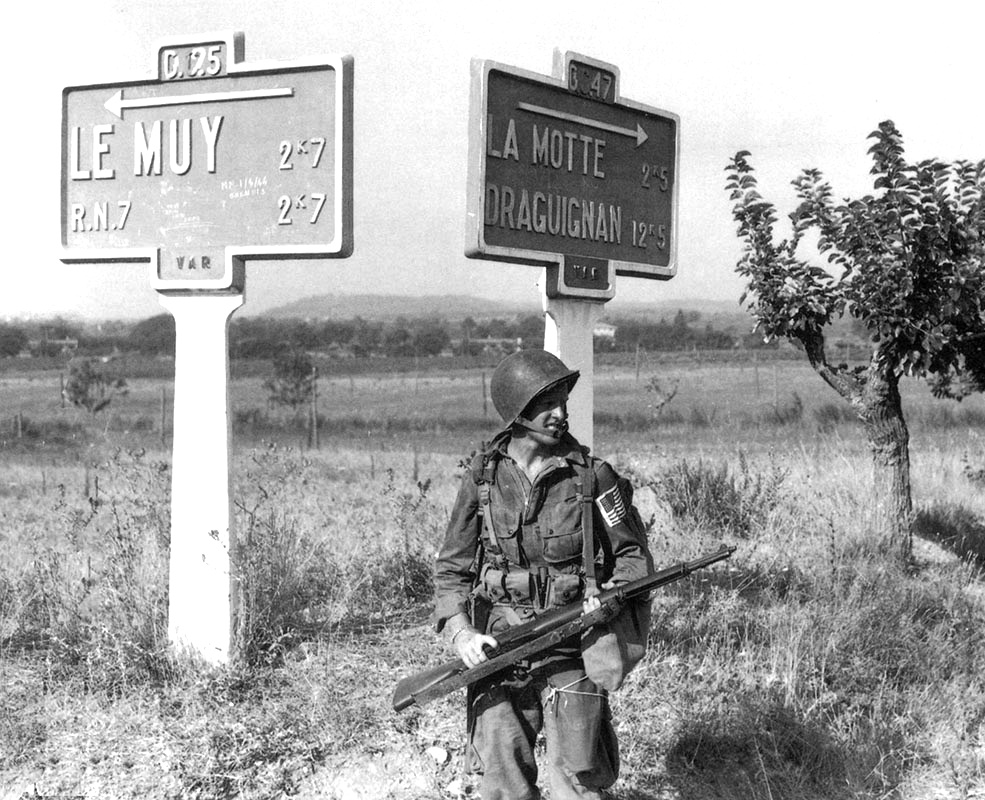Document Source: Infantry School, General Section, Military History Committee, Fort Benning, Georgia, Advanced Officers Course (1946-1947). Operations of Easy Company, 517th Parachute Infantry Combat Team, in a River crossing and attack at La Roquette, France, August 27-28, 1944, Southern France Campaign, Capt Walter G. Irwin, Attached Officer

INTRODUCTION
This archive covers the operation of Easy Company, 517th Parachute Infantry Regimental Combat Team, (First Airborne Task Force), August 27-28, 1944, in the crossing of the Var River and the attack on the town of La Roquette, in the initial phase of the invasion of Southern France. To properly orient the reader as to the purpose and mission of this unit it is necessary to discuss the train of events preceding this operation. The Allies had successfully invaded Hitler’s Fortress Europa on June 6, 1944, and by the middle portion of the month of August, were pushing a mailed arm through a disorganized enemy withdrawing to their much vaunted Siegfried Line Defenses. It had been planned by the Allied staff to further aid the moment of victory and prevent the reinforcement of the Siegfried Line from troops in Italy and Southern France that the Allies would launch an invasion on the Southern Coast of France, this to be known as Operation Anvil for planning purposes and Operation Dragoon for the Execution. Operation Dragoon was to be a joint airborne/amphibious operation and would depart from Allied-held Italian Territory to land on the Southern Coast of France, east of Toulon.
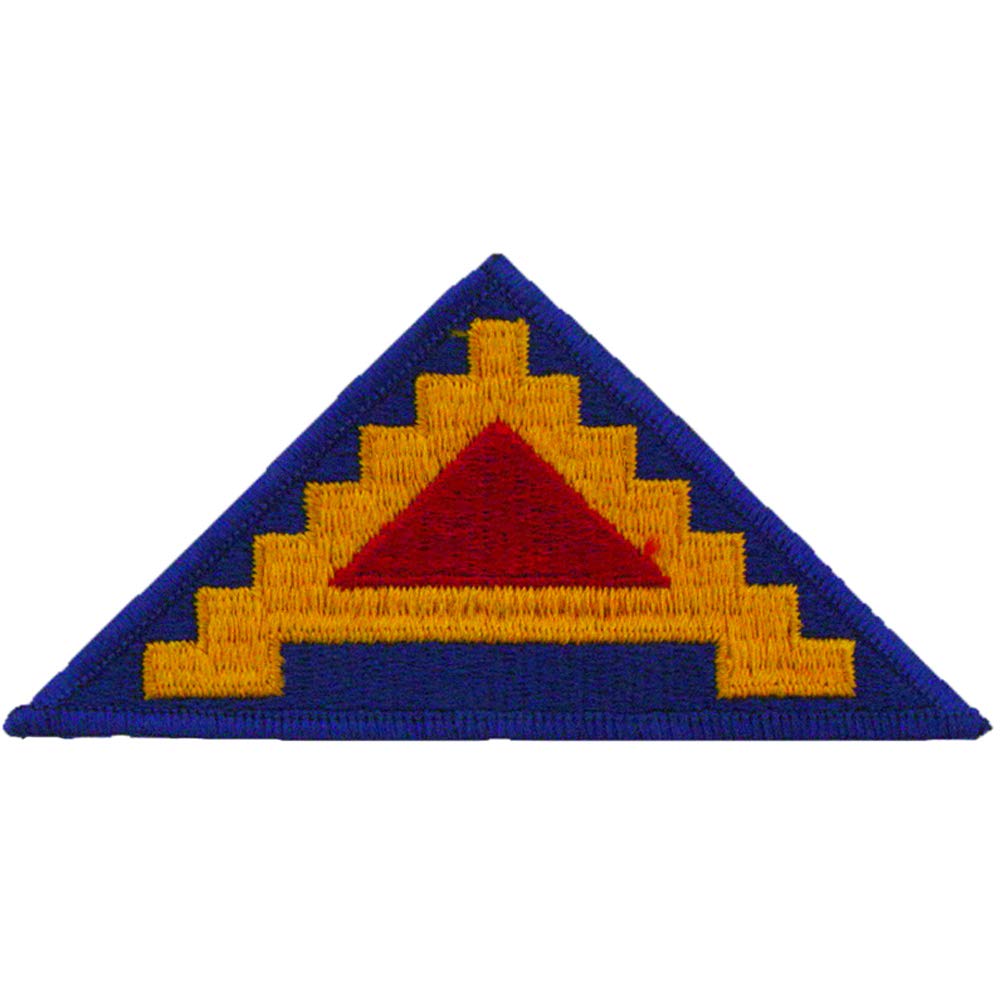
 This planned invasion force was to be placed initially under the command of the US Seventh Army, Gen Alexander M. Patch. American land elements consisted of the US 3rd Infantry Division, the US 36th Infantry Division, the US 45th Infantry Division, and the First Airborne Task Force with attached service and support units. Further, Allied forces embraced in this
This planned invasion force was to be placed initially under the command of the US Seventh Army, Gen Alexander M. Patch. American land elements consisted of the US 3rd Infantry Division, the US 36th Infantry Division, the US 45th Infantry Division, and the First Airborne Task Force with attached service and support units. Further, Allied forces embraced in this 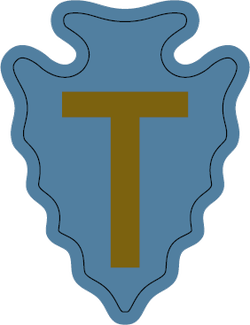
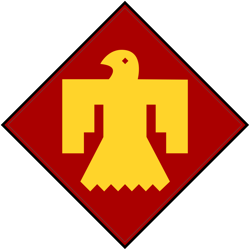 command were two French Corps which consisted of the five French Infantry Divisions and two French Armored Divisions, and in its entirety to be known as the French Army. These troops were commanded by Gen de Lattre de Tassigny and would have the honor of being the first French troops to fight on native soil since the defeat of France in 1940. In general, the mission of the major elements was US VI Corps, Gen Lucian K. Truscott commanding US Forces, would land on D-
command were two French Corps which consisted of the five French Infantry Divisions and two French Armored Divisions, and in its entirety to be known as the French Army. These troops were commanded by Gen de Lattre de Tassigny and would have the honor of being the first French troops to fight on native soil since the defeat of France in 1940. In general, the mission of the major elements was US VI Corps, Gen Lucian K. Truscott commanding US Forces, would land on D-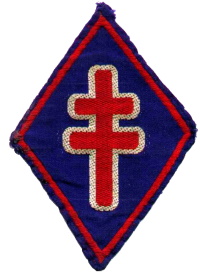
 Day, August 15, 1944, to secure a beachhead east of Toulon, exploit north along the Rhöne River & Valley to Lyon and Vichy; French forces would land on D+1, pass through the US VI Corps and seize the Harbors of Toulon and Marseilles, which were to be refitted for use to supply this southern army.
Day, August 15, 1944, to secure a beachhead east of Toulon, exploit north along the Rhöne River & Valley to Lyon and Vichy; French forces would land on D+1, pass through the US VI Corps and seize the Harbors of Toulon and Marseilles, which were to be refitted for use to supply this southern army.
THE GENERAL SITUATION
£nemy troops in the area consisted of the German 19.Army (Gen Friedrich Wiese) embracing two Corps of eight Infantry. Divisions and one Panzer Division in position from the Spanish Border east to the Italian Border. Combat efficiency could be considered fair, strength roughly 15% of normal, and firepower somewhat limited to smaller type weapons. With the exception of the 11.Panzer-Division (Gen Wend von Wietersheim), the units in this command were of a reserved nature, or units sent to the area for refitting and replacement. Replacements that had been received had been largely Russians, Czechs, and persons of Balkan descent and presumed to be serving under duress. The US VI Corps would assault with three divisions simultaneously in the selected beachhead area and advance rapidly inland to contact friendly airborne forces previously dropped. Airfields in the vicinity of Le Muy would be prepared immediately for use of Tactical Air Command. All units would hold on reaching Objective N°1 ‘Blue Line’, and would continue the expansion on order. Amphibious forces were successful in landing in the vicinity of St Raphael, St Tropez, Fréjus areas on D-Day, August 15, 1944. Airborne forces of the 1st Airborne Task Force, landed via parachute on D-Day, H-Hour (minus 0430) on DZ’s in the vicinity of Le Muy, Les Arcs, La Motte and successfully blocked any movement of enemy reserves from the west and north that might have driven our amphibious forces back into the sea. A reinforcing para-glider unit drop arrived in the secured DZ at 1800 on D-Day.
The VI Corps assault unit successfully overcame the stout German defenses in the coastal area and by D+2 had secured their objective of ‘Blue Line’. The VI Corps ordered the 3rd, 36th, and 45th Divisions to send certain of their forces to Le Muy on August 17, to be formed into an Armored Group to be known as Task Force Butler and to be prepared to execute the second phase of Operation Dragoon with the remainder of the Divisions. The time had arrived to exploit the initial advantage held by the US 7-A. On August 18, the exploitation had begun. The US 3rd Division was to seize and hold positions in the south portion of the beachhead until passed through by the II French Corps, thence to advance along Highway 7 (RN-7) to the Rhöne River Delta; the US 45th Division would advance northwest, skirting the Maures Mountains to the North; US 36th Division would advance eastward towards Cannes, and as soon as the beachhead was secured, be prepared to thrust northward along Highway 85 (RN-85); II French Corps would advance west and seize Toulon and Marseilles; Task Force Butler was to drive to the Durance River near Manosque or St Paul, seize a bridgehead and be prepared to drive either north to Grenoble or Montélimar.
GENERAL SITUATION FIRST AIRBORNE TASK FORCE
This fast-moving action on the part of the 3-ID, the 36-ID, and the 45-ID, caused the east (right) flank of the VI Corps to be exposed to any forces that might be sent from the German Forces in Italy and held the possibility of a thrust by the enemy to separate the fast moving US Forces from their supply bases in the beachhead area. To close this gap and protect the east flank, the VI Corps ordered the 1-ABTF to advance to a line Fayence – La Napoule, and prevent any enemy movement to the west. This line was eventually extended to the Franco-Italian Border from the Mediterranean Sea to the Larche Pass, some fifty miles to the north. Enemy troops now facing the advancing 1-ABTF were identified as the 146.Infantry-Division (Gen Otto Schönherr); 200.Grenadier-Regiment (90.Panzer-Division, dismounted): 80.Infantry-Regiment (54. Infantry-Division); an unknown number of a special SS Force, and supporting Corps Artillery. These units fought a bitter delaying action, yielding only when outflanked or killed, however, indications pointed to a lowering of morale by personnel of the 148.Infantry-Division by reports of limited supplies, and high desertion rate.
It became increasingly apparent that the German High Command would not attempt any large-scale operation from the Turini Pass (Nice-Genoa Highway) when all elements of the delaying force initiated a wholesale and complete demolition program of all roads, bridges, culverts, and railroad tunnels. This action did little to change the mission of the 1-ABTF except now importance would be placed on preventing raids of small forces on the Seventh Army.
ADVANCE OF THE 517-PRCT TO THE VAR RIVER

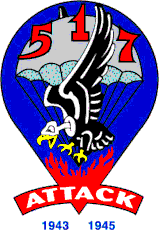 Troops of the 1-ABTF having secured the line Fayence – La Napoule by August 20, now ordered the 517-RCT to act as the left flank unit of the Task Force on the eastward advance to the Italian Border. The first objective given to the RCT was the town of St Vallier which fell to an attack on August 21. An additional mission was given to the RCT at this time; the responsibility of patrolling the roads on the left of the Task Force sector and maintaining contact with VI Corps at Digne, a considerable distance for foot troops. To accomplish this task the reconnaissance platoon of the 645-TDB was attached to the unit. The regimental combat team moved slowly across the rugged mountain terrain with objectives of St Cézaire-sur-Siagne – Le Bar-sur-Loup north along the Loupe River to Coursegoules to Le Broc which overlooked the Var River.
Troops of the 1-ABTF having secured the line Fayence – La Napoule by August 20, now ordered the 517-RCT to act as the left flank unit of the Task Force on the eastward advance to the Italian Border. The first objective given to the RCT was the town of St Vallier which fell to an attack on August 21. An additional mission was given to the RCT at this time; the responsibility of patrolling the roads on the left of the Task Force sector and maintaining contact with VI Corps at Digne, a considerable distance for foot troops. To accomplish this task the reconnaissance platoon of the 645-TDB was attached to the unit. The regimental combat team moved slowly across the rugged mountain terrain with objectives of St Cézaire-sur-Siagne – Le Bar-sur-Loup north along the Loupe River to Coursegoules to Le Broc which overlooked the Var River.
Enemy resistance had been only a token force or demolition crew who demolished all bridges, cratered roads, and generally disrupted the advance along any roadway, however, interrogation of Prisoners by S-2 indicated that the Var River could be expected to be defended in force. It will also be noted that all infantry units assigned to the 1-ABTF were lightly equipped, without adequate transportation, and not designed to enter sustained combat. Coupled with that the enemy had blown all bridges on his withdrawal and had effectively caused the units to fight across the extremely mountainous terrain. Supplies of necessity were limited, and ammunition and rations were at a premium. To assist the foot units of the 517-PIR each battalion had been issued some fifteen mules which were used to transport ammunition, heavy weapons, and a limited amount of other necessities. Rations had to be carried on the person and resupplied when vehicles could be rerouted to the column or the Engineers could fix a suitable crossing. These conditions, coupled with the fact the units were facing a numerically equal force in an ideal defensive country, made the progress of the units extremely costly and painful.
SECOND BATTALION SITUATION AUGUST 27 1944
The 2nd Battalion 517-PRCT moved along the highway Bézaudun-les-Alpes – Le Broc and approached the Var River opposite the town of La Roquette-sur-Var, which was situated on the eastern bank and commanded the only available bridge across the Var in this zone. This bridge was as yet undamaged. The Battalion CP was established in the town of La Broc by the Battalion CO, Lt Col H. J. Seitz, by mid-morning August 27. Battalion had received orders that the bridge in this area would be secured intact if at all possible, for a supply route to be used by the supporting units on the advance to the east. A combat patrol consisting of a reinforced platoon had been sent to this bridge location early on the morning of August 27 and had surprised the enemy security forces charged with the holding or demolition of the structure. As the battalion moved into the vicinity of Le Broc, the patrol was finding a most determined enemy making successive attempts to demolish the structure, which had been previously mined for demolition. Enemy forces would lay down a tremendous concentration of machine-gun and mortar fire, and under the protection of this would send patrols to attempt the destruction, but each time these were driven back by a just as determined patrol from the battalion.
It was felt by the Battalion CO that if a force could effect a crossing on this bridge and neutralize the demolitions crew, they could establish a bridgehead sufficient to allow the remainder of the Regiment to advance. Fox Co, reinforced with a section of LMG from the 3rd Battalion HQs Co, was given this mission. Attempts were made to force a crossing near the bridge site but it was found that due to the nearly perfect defensive terrain on the east bank of the river and the excellent observation, the crossing was not worth the cost in casualties. Enemy machine gun and mortar fire effectively discouraged all attempts to send even small patrols across during daylight hours. This situation, however, worked equally as well for both forces. The mortar, machine gun, and supporting artillery fire of Fox Co denied the enemy any success in his numerous attempts to destroy the structure. Recon patrols were dispatched to find possible crossing sites but in each case of a likely crossing site, the area was well covered by well-directed automatic small arms and mortar fire. Attempts by the attached engineer platoon of the 596th Airborne Engineers to clear a path through, the extensive minefield proved unsuccessful due to enemy fire and the very nature of the emplaced mines.
Six-foot wooden poles had been set in the river bed approximately twenty-five feet apart. From the tops of these wires had been strung to connect each pole, and suspended from between each of these poles, hanging nose down, approximately eight inches from the ground was an activated 170-MM high explosive projectile with quick fuze. To stumble into the wire or molest it so that the projectile would touch the ground would cause the projectile to explode. To make matters more difficult anti-personnel mines had been sprinkled throughout the area. It was apparent that a force must be sent across the river at some other location to seize the town of La Roquette and the hill mass to permit the Battalion to advance and to seize the bridge intact.
SECOND BATTALION INTELLIGENCE SITUATION
Weather at this season of the year was extremely warm during daylight hours but was disagreeably chilly during darkness. It had not rained in the area for some weeks making the scattered scrub growth dry and highly inflammable. The terrain in this area consisted of aeries of jagged, rock-studded, scrub-covered mountain ridges rising to a height of some fifteen hundred meters at the crests, with the Var RiverVar River cutting a course running generally north-south through the terrain mass. The mountains extended to the banks of the Var and dropped abruptly down to the river edge. This being the dry season of the year, the river was approximately one hundred fifty to two hundred yards in width with a reported average depth of three to five feet. The bridge across the Var River in this area was of concrete construction, two lanes in width, pier supported, and approximately three hundred yards in length. The mountain ridge due east of the bridge site rises to a height of six hundred meters and commands the approaches on either bank. Highway N°202 parallels the east bank of the river southward to Nice.
The enemy in the area was estimated to be a reinforced battalion of infantry, with positions on the ridge line situated east of and paralleling the Var River. Approximately one company is estimated to be in and in the vicinity of La Roquette. The enemy was well dug in and had prepared positions in the area to command all approaches to the bridge and had organized all key terrain features along the east bank of the river. Extensive anti-personnel minefields were located in the river bed in the area of the bridge and extended approximately one mile north and south. Wire barriers had been erected on all likely avenues of approach to the east bank defenses. Traveling patrols moved along Highway 202 during hours of darkness. Support was in form of an unknown number of mortars (8-CM and 12-CM) and a few pieces of small-caliber mountain artillery. No tanks were reported in the area.
SECOND BATTALION ATTACK ORDER (August 27 1944)
By 1200 hours, on August 27, the Battalion situation was stagnant. Fox Co was undergoing no intense hardship as a forward movement had ceased but the engagement thus far could be called a checkmate. A most welcome visitor was ushered in to see the Battalion CO at approximately 1200, the name was unknown, to the members of the command, but later known as ‘Louie’. He proved to be a member of the well-organized FFI Forces in the area and was volunteering his services and knowledge of the terrain. After verification of his status from Task Force Headquarters, Louie stated that down the river, approximately one mile the channel was shallow and that the area was now unguarded. Further, the FFI had a schedule of all enemy traveling patrols on Highway 202. Map study and reports from the I&R section and the Field Artillery Aerial Observer indicated this could be true. To preclude any hint of a crossing in this place all patrol activity in this area was withdrawn until darkness. Thus with the stage set the Battalion Commander issued his order.
The 2nd Battalion would attack at 1700, August 28, seize the bridge across the Var River, the hill mass east of the bridge, and the town of La Roquette. In order, would advance to the next objective of Levens. Support would be given by the 450th Parachute Field Artillery Battalion and Battalion Headquarters Company 81-MM mortar platoon. Fox Co would continue pressure on the bridge until H-hour; Dog Co would move to the area generally to the west and south of Fox Co and support the crossing by fire, which would be committed on Battalion order. H-hour, Fox Co would force a bridge crossing and seize the high-ground east of the bridge. Dog Co would, on order, advance rapidly to the vicinity of La Roquette and assist Easy Co should it be needed. Easy Co, reinforced, was given the mission of making a river crossing, by stealth, at 0200, August 28, moving to the rockbound ridge in the rear of La Roquette, and cutting the La Roquette – Levens Highway at 1500, and attack the town of La Roquette from the rear at 165O. Artillery liaison would be with Easy Co and would place fire on enemy positions firing on the bridge site commencing at 1550.











